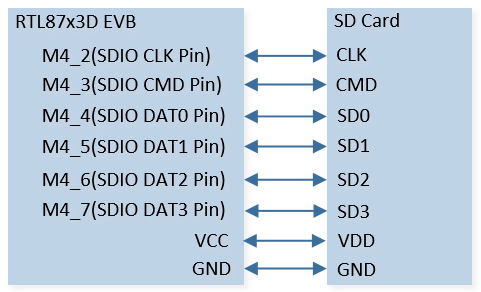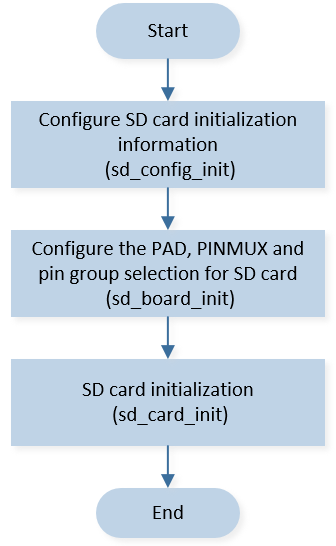SDIO Write Read
This sample code demonstrates the read and write functions of SD card. Read the data at the specified address of the SD card, write the specified data to the address, and then read the data at the address for comparison.
Requirements
For hardware requirements, please refer to the Requirements.
Wiring
Take RTL87x3D group1 as an example, connect P4_2 ~ P4_7 on EVB to CLK, CMD, DAT0, DAT1, DAT2 and DAT3 of SD card respectively. And the VCC and GND pins on EVB are connected with the VDD and GND of the SD card. The specific group pins of different ICs are shown in SDIO Group Pins in RTL87x3D and SDIO Group Pins in RTL87x3E and RTL87x3EP.
The hardware connection of SDIO demo code is shown in the figure below.

SDIO Demo Code Hardware Connection Diagram
Configurations
-
The following macros can be configured to adjust test parameters for SD card operations, including block numbers, and the starting address.
#define BLOCK_NUM 1#define OPER_SD_CARD_ADDR 0x8000
-
The following
T_SD_CONFIGstructure can be configured to modify card type, group pins, bus width, clock and power pin releated.static const T_SD_CONFIG sd_card_cfg = { .sd_if_type = SD_IF_SD_CARD, .sdh_group = GROUP_0, .sdh_bus_width = SD_BUS_WIDTH_1B, .sd_bus_clk_sel = SD_BUS_CLK_20M, .sd_power_en = 1, .sd_power_high_active = 1, .sd_power_pin = P5_6 };
-
The entry function is as follows, call this function in
main()to run this sample code. For more details, please refer to the Initialization.sdio_demo();
Building and Downloading
For building and downloading, please refer to the Building and Downloading.
Experimental Verification
-
Press the Reset button on the EVB, observe the SD card initialization status in the Debug Analyzer. If the card is successfully recognized, the following string will be printed.
SD_InitCard: status: SD_OK
-
Read 512 bytes of data from the SD card and prints the initial card data at address 0x8000. If read success, the following string will be printed.
sd_print_binary_data: buf[0] ... sd_print_binary_data: buf[4]
-
Write 512 bytes of data to the SD card address 0x8000, the data is 0~0xff + 0~0xff, and will prints the write data.
sd_print_binary_data: buf[0] 00 01 ... 76 77 ... sd_print_binary_data: buf[4] E0 EE ... FE FF
-
Read 512 bytes data from the card address 0x8000. If read success, prints the data of 0~0xff + 0~0xff.
sd_print_binary_data: buf[0] 00 01 ... 76 77 ... sd_print_binary_data: buf[4] E0 EE ... FE FF
Code Overview
Source Code Directory
For project directory, please refer to Source Code Directory.
Source code directory:
sdk\src\sample\io_demo\sdio\sdcard\sdio_demo.c.
Initialization
SDIO initialization flow is shown in the following figure.

SDIO Initialization Flow Chart
The codes below demonstrate the SDIO initialization flow.
-
Call
sd_config_init()to config the SD card initialization information. The initialization parameters for SDIO are configured as follows:SDIO Initialization Parameters SDIO Hardware Parameters
Setting in the
sd_cfgSDIO
Card Type
Pin Group
Bus Width
Clock
Power Pin
Power Pin High Active (high/low active)
1
Power Pin Enable
1
Call
sd_board_init()to config the PAD, PINMUX and pin group selection of SD card.Call
sd_card_init()to initialize the card recognition, and tune delay to increase stability for high-speed data transfer.
Functional Implementation
SDIO Write Read
-
Call
sd_write()to write the prepared data intest_bufto the SD card.for (uint32_t i = 0; i < BLOCK_DATA_SIZE; i++) { test_buf[i] = i & 0xff; } sd_status = sd_write(SD_HOST_ID, OPER_SD_CARD_ADDR, (uint32_t)test_buf, SINGLE_BLOCK_SIZE, BLOCK_NUM); if (sd_status != 0) { return ; }
-
Call
sd_read()to read the data in SD card, then stored intest_buf.memset(test_buf, 0, BLOCK_DATA_SIZE); sd_status = sd_read(SD_HOST_ID, OPER_SD_CARD_ADDR, (uint32_t)test_buf, SINGLE_BLOCK_SIZE, BLOCK_NUM); if (sd_status != 0) { return ; }